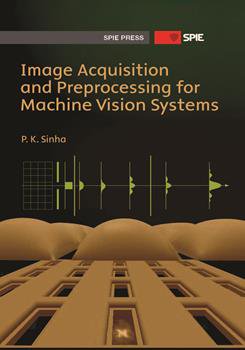|
The FOV dictates the geometric features of target objects, so an image captured from the most convenient location or camera orientation may not be compatible with the required processing tasks. In cases where image alignment or registration is critical, coordinate transformation is performed as part of the preprocessing operations to spatially resize or relocate a captured image or a ROI within the image frame. Spatial transformation is also useful to correct images distorted during capture due to, for example, setup misalignment or lens imperfection. A specific feature of such operations is that each source (input) image pixel carries over its intensity value as it moves to a new location on the transformed (output) image. However, if the coordinate transformation relation is such that some of the new locations in the output image are noninteger values (subpixel locations), then the corresponding gray-level value from the input image may be lost or allocated to a neighboring location in the output image. In this context, lost means that a zero gray-level value (intensity hole) is inserted into the transformed (output) pixel location; assigning a gray-level value to an arbitrary location creates artifacts in the output image. Interpolation is added to ensure that noninteger locations generated by the transformation mathematics are assigned to user-defined locations such that the output image (or ROI) possesses the same overall spatial intensity distribution property as the input image (source ROI). If a bandlimited source waveform is sampled at the Nyquist or higher frequency, an exact reconstruction (i.e., ideal interpolation between the sampled data points) is possible by using an ideal low-pass filter. In the spatial domain, a lowpass filter corresponds to a sinc function, and in the frequency domain it is represented by a rectangular (box) function (Appendix B, Sec. B.4). Since the sinc function is defined over the range -∞ < x < ∞, the ideal interpolation is not physically realizable. Therefore, polynomial interpolation functions are grouped under global interpolation and piecewise interpolation. |
|
|


